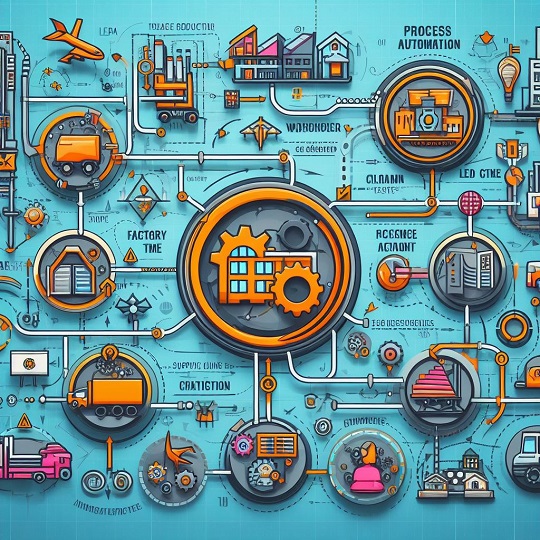Enterprise Resource Planning (ERP) systems are essential tools for businesses aiming to make their operations smoother, improve efficiency, and stay competitive.
But implementing ERP can be tricky, and there are common challenges that can disrupt even the best-laid plans.
This guide covers 10 common pitfalls in ERP implementation and offers advice on how to overcome them.
Before we go further into this topic, don’t forget to follow my LinkedIn account. You’ll get more helpful insights on supply chain management there.
Table of Contents
Inadequate Planning
In the complex world of enterprise resource planning (ERP), not planning enough can lead to failed implementations.
Rushing into the process without understanding a company’s needs, goals, and potential challenges can set the stage for disaster.
Successful ERP implementation requires careful planning, including a deep look at current processes and strategic analysis of future objectives.
This groundwork is crucial for building a strong ERP system that aligns with the organization’s goals.
A realistic timeline, based on this assessment, acts as a guide, preventing the implementation from going off course.
To overcome challenges from inadequate planning, organizations should use a methodical approach that involves stakeholders at all levels.
Inclusive planning, gathering insights from different departments and key decision-makers, provides a holistic understanding of the company.
By promoting collaboration during the planning phase, organizations can identify potential issues early and create strategies to address them.
Ultimately, recognizing the importance of thorough planning is key to a successful ERP implementation, ensuring a smooth transition and long-term operational success.
Poorly Defined Objectives
In the complex world of implementing ERP, having clear and well-defined goals is crucial. These goals act as guiding stars, directing the implementation journey.
When objectives are unclear or based on unrealistic expectations, challenges like scope creep, cost overruns, and stakeholder frustration can threaten the success of the ERP initiative.

To avoid these risks, organizations should start the ERP journey with a clear vision, precisely stating goals.
Whether it’s improving efficiency, cutting costs, or enhancing customer satisfaction, objectives need to be clearly outlined and aligned with the capabilities of the chosen ERP system.
The key to a successful ERP implementation lies in aligning organizational goals with the functions of the ERP solution.
This harmony ensures that the system not only meets current needs but also sets the stage for future growth and innovation.
By creating a well-defined roadmap rooted in realistic objectives, organizations set the foundation for a smooth and successful ERP implementation that resonates with stakeholders and drives positive change across the business.
Insufficient User Involvement and Training
User resistance is a significant challenge in implementing ERP systems, often due to unfamiliarity or concerns about technology changes.
To tackle this, organizations should take a proactive approach that prioritizes involving users in the process.
Getting user input early on, addressing their concerns, and providing thorough training are crucial steps.
This user-focused strategy not only increases the chances of successful adoption but also creates a positive and collaborative environment, reducing resistance to operational changes.
The key to overcoming user resistance is highlighting the practical benefits of the ERP system.
When users see how the new system aligns with organizational goals and improves their daily tasks, they are more likely to welcome the change.
Communication is essential throughout the implementation, ensuring transparency and giving users a platform to voice their concerns.
By promoting a culture of continuous learning and engagement, organizations can turn user resistance into enthusiasm, leading to a smoother transition to the new ERP system and minimizing disruptions to business operations.
Integration Challenges
ERP systems promise to bring together different business functions for a more efficient organization.
However, making this integration work smoothly has its challenges.

Problems often arise when existing systems and processes don’t match up with the new ERP software.
To handle this well, organizations need to carefully examine their current setup, finding any issues that might cause problems during integration.
A smart approach to moving data and integrating it is crucial to avoid disruptions in ERP implementation.
This means not only transferring data from old systems to the new ERP platform but also doing it seamlessly to keep the data accurate and intact.
Investing in strong integration solutions, like middleware, APIs, or other tools, helps connect different systems.
This thorough analysis and planning ahead are crucial to ensure a smooth transition to the new ERP system, reducing disruptions and letting the organization make the most of its integrated business functions.
You might also like:
- Top 10 Job Functions Suitable for Introverts in Supply Chain Management
- Decoding SOP Discipline: A Close Look at How Managers Keep the Supply Chain in Check
Underestimating Data Migration Complexity
In the world of ERP implementation, moving data is a crucial step that can either help the organization or cause big problems if not done right.
People often overlook how tricky data migration can be, but it has a big impact. If data is incomplete or wrong and not handled carefully, it can slow down operations, mess up decision-making, and even harm the new ERP system.
Understanding how important this is, organizations need to spend enough time and resources cleaning, checking, and moving data from old systems to the new ERP platform.
To handle the challenges of data migration, a complete plan is essential. This means not just focusing on the technical side of moving data but also making sure the information being moved is good quality and relevant.
Cleaning up data, doing checks, and careful planning are all part of this plan. By putting effort into these steps, organizations can make sure their data is reliable, reduce the chance of mistakes, and smoothly transition to the new ERP platform. This sets the stage for the new system to work well, giving users accurate and trustworthy information for smart decision-making across the organization.
Vendor Selection and Relationship Management
Choosing an ERP vendor is a big decision that can greatly impact the success of the implementation process. Unfortunately, some organizations prioritize low costs, making it the main factor in selecting a vendor.
However, focusing only on costs can lead to overlooking other important factors for the long-term success of the ERP system.

It’s crucial to consider the system’s flexibility, the quality of ongoing support from the vendor, and their track record in successful implementations.
To ensure a strong and lasting partnership, organizations need to view the vendor selection process broadly, balancing cost concerns with these critical factors.
Establishing a good relationship with the chosen ERP vendor is not just a nice-to-have; it’s essential for successful implementation.
Open communication from the beginning allows for a collaborative approach throughout the process, becoming key to addressing challenges quickly and effectively.
By fostering a partnership mindset and aligning the organization’s goals with the capabilities of the ERP vendor, businesses can handle potential issues with flexibility, ensuring a smoother implementation journey and laying the groundwork for a long-lasting and beneficial relationship.
Scope Creep
Scope creep in ERP implementation is like a sneaky problem that, if not kept in check, can mess up the whole project.
This happens when extra features or requirements are added without thinking about how they’ll affect the project’s timeline, budget, and overall success.
To avoid going off track from the initial plan, organizations need to be watchful and manage scope creep. This means having a strong change management process that carefully evaluates and approves any changes to the project’s scope.
The process should make sure that the proposed changes fit well with the main goals of the ERP implementation and contribute positively to the project’s overall success.
Having a change management process isn’t just a formality; it’s a smart move to stay in control and keep things on track during the ERP implementation.
It involves clear communication and getting input from key people to decide if proposed changes are a good idea.
With a disciplined approach to change management, organizations can reduce the risks of scope creep, keep the project on track, and make sure the ERP system matches the original goals, leading to a smoother and more successful implementation.
Inadequate Testing
Testing is incredibly important in the world of ERP implementation. If testing isn’t done well before the ERP system goes live, it can lead to serious problems like system crashes, data issues, and disruptions in operations.
These challenges don’t just affect the ERP system; they can cause issues throughout the whole organization, messing up day-to-day tasks and hurting the goals of the implementation.

To make sure ERP deployment is successful, organizations need to invest time and resources into thorough testing methods.
To avoid potential problems, a comprehensive testing approach is necessary. This includes unit testing, where individual parts are checked for how well they work; integration testing, ensuring different parts work together smoothly; and user acceptance testing, where end-users make sure the system meets their real-world needs.
Each testing phase is a way to find and fix problems before they become big issues, giving organizations the chance to improve the ERP system for the best efficiency and reliability.
Thorough testing isn’t just a checkbox in the implementation process; it’s a crucial strategy for building a strong and high-performance ERP infrastructure.
You might also like:
- The Contradiction in Supply Chain Experience: Revealing Both Success and Failure
- Unveiling the Hidden Costs: The Impact of Meaningless Actions on Waste in Supply Chain Management
Lack of Executive Support
Successful ERP implementation relies on strong leadership and solid support from top executives.
When executives fully commit to the ERP project, it creates a positive impact throughout the organization, making success more likely.
On the flip side, if top-level executives aren’t on board, implementing ERP becomes tougher. It’s harder to get the necessary resources, overcome resistance from different departments, and keep up the momentum for a smooth transition.
The commitment of top executives is crucial not just for providing the budget and manpower but also for establishing a shared vision that everyone in the organization understands.
To make sure ERP implementation succeeds, organizations need to make sure top executives understand the strategic importance of the ERP system. Executives should see how the ERP system fits into the overall goals and growth plans of the organization.
By actively supporting the implementation process, they become advocates, breaking down resistance and creating a culture where everyone not only recognizes but embraces the benefits of the ERP system.
Essentially, the commitment of top executives sets the tone for the entire organization, making the ERP implementation smoother and more efficient, with lasting benefits.
Failure to Continuously Improve
Successfully implementing ERP is just the start, not the end, for organizations aiming for ongoing excellence.
After implementation, it’s crucial to commit to continuous improvement.

Failing to adapt to changing business needs, new technology, or shifts in the market can make the ERP system outdated quickly.
Regular assessments, built into the organizational culture, help respond dynamically to changes both inside and outside the organization.
By keeping an eye on emerging trends and industry developments, organizations can update their ERP systems proactively to meet new challenges and make the most of evolving opportunities.
The key to long-term success with ERP is a strong commitment to ongoing improvement.
Organizations should see their ERP systems as living things that need regular attention and tweaking.
This commitment means not just keeping the software up to date but actively finding ways to make it work better, improve user experiences, and align with changing business goals.
By creating a culture of continuous improvement, organizations set themselves up to get the most out of their ERP investment, ensuring the system stays a valuable asset that can adapt and grow with the ever-changing business landscape.
Conclusion
Starting ERP implementation is like navigating uncharted waters, requiring careful planning. It begins with detailed planning that includes understanding organizational needs, goals, and possible challenges.
Involving users from the start is crucial for a smooth transition. Organizations need to address potential problems upfront, knowing that issues like data migration, integration, and user resistance can be major threats to success.
To unlock the full potential of ERP systems, organizations should proactively manage challenges. Choosing the right vendor, building strong relationships, and having change management processes in place help reduce risks and increase the chances of success.
Thorough testing, smart data migration plans, and continuous improvement efforts make the ERP system more resilient. This leads to improved efficiency, streamlined operations, better decision-making, and sustainable growth.
A successful ERP implementation is more than just a tech upgrade; it’s a transformative journey that, when done right, can push organizations toward increased competitiveness and operational excellence.
I hope you find it helpful!
Please share this article with your colleagues so they can also benefit. For more insights on supply chain management, follow my LinkedIn account. You’re free to use all articles on this blog for any purpose, even for commercial use, without needing to give credit.

 by
by 

